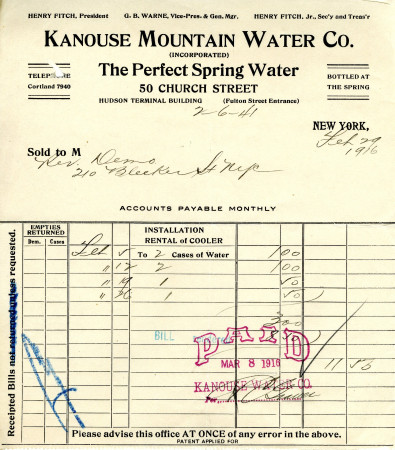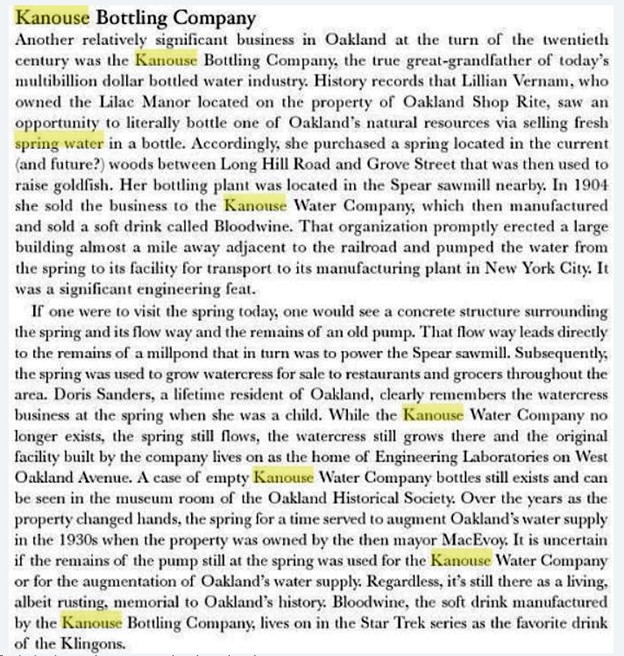BEVERAGE COMPANIES IN NEW YORK CITY CIRCA WWI

Kanouse Mountain Water Co.. (1916, February 29). [Bill of Sale]. Pompeii Papers Collection. Center for Migration Studies. New York, NY.
The second image, is a receipt from the Kanouse Mountain Water Company located on 50 Church Street. Water is a necessity in everyone’s life, so it was not unusual for Reverend Anthony Demo to purchase cases of water weekly from the company. The receipt shows that the Kanouse Mountain Water Company provided The Shrine Church of Our Lady of Pompeii with weekly cases of water to help with basic needs of the church. It was a common practice for churches to dilute altar wine with water to conserve enough wine to last the daily masses throughout the week (Thurston, 1912).
The Kanouse Mountain Water Company was located in the Hudson Terminal Building in Lower Manhattan. The building was still standing until 1971 when it was demolished to make way for the World Trade Center towers (Kanouse Mountain Water Company, n.d.). Many historical buildings in New York City have been destroyed to make way for modern architecture and to create more jobs for the American people.
Even though water was considered a necessity, it was not saved from the war tax. It was voted that “[m]ineral water will be taxed 15 cents per gallon” during WWI to help produce funding for the war (Submits New Tax Plan, 1918). With many companies, churches, and families purchasing water, the high war tax would have created a substantial amount of revenue to be used in the funding of war supplies to help defend our country and it’s rights to Life, Liberty, and the Pursuit of Happiness.
Ed Zindel 4/1/2016
KANOUSE MOUNTAIN: “A VERY FINE SPRING WATER”
In response to a request by the Kanouse Mountain Water Company, the New Jersey Department of Health inspected their plant on December 15, 1909. In a two page report that appeared in the Documents of the Legislature of the State of New Jersey; the spring, the pipeline and the bottling process were described in detail.
In summary, the Assistant Chief of the State Department of Heath, Arthur G. Fowler, wrote the following: “A sample of water was collected from the filling machine and analyzed. The analysis card accompanies this report. It is interesting to note the low bacterial count, which with the good chemical analysis shows that this water is a very fine spring water. In conclusion, I desire to state that I believe that this water is bottled under the most sanitary conditions in this State, and the source of the water is apparently free from any pollution at present and well protected from any future contamination”.
Other interesting items included in the report are the facts that the 3” pipeline was 7000 ft in length and the difference in elevation between the spring and the plant was 90 feet. This differential resulted in pressure that was described as “very great.” Additionally, the workers were required to take showers at the beginning of their shift and put on a “white duck suit”.
Kanouse was also proud of the fact that the bottle cleaning process was performed with a piece of equipment called “The Twentieth Century Soaking Machine. Their capacity at the time of the inspection was 1500 gallons per day and their markets were in New York City, Jersey City, and Hoboken.
In addition to spring water, they also produced carbonated water, and were planning to bottle “a brand of ginger ale. The standard size bottle used by Kanouse was 18 pints, but they also provided 5 gallon carboys that could be used with turn-of-the-century ice cooled dispensers.
When I played on this property in the late 50’s and early 60’s, Engineering Laboratories, Inc. had modified the Kanouse plant for their use, but a large pile of broken bottles and carboys remained on the shore of a pond that was located behind the Romaine homestead. In retrospect, I wish I had collected a few of the green ground glass stoppers that included the name Kanouse and the words: “A Perfect Spring Water” in raised letters.
Anyone interested in seeing what is left of the original Kanouse Plant can park on Pool Hollow Road and follow the railroad tracks to the back of the building. It was beautiful when built, and hasn’t changed very much over the years.
On a separate, but related topic, the folks at the Engineering Labs were definitely “Kid Friendly”. One of many ways we entertained ourselves was to walk between the building and the railroad tracks where we picked up colorful plastic beads, and rods that were discarded when the floors were swept. We also found stones that were polished to a bright shiny finish in drums used to tumble the beads. I often kept one of these stones in my pocket, and if I listen, I can still hear the cadence of the turning drums.
If we rang the bell on the huge door located on the north side of the building, the workers would give us empty 50 gallon fiber barrels that were used to ship the plastics. We would then take turns climbing inside the barrels while our friends rolled us down the long hill between the building and West Oakland Ave. After being rolled, we climbed out of the barrels laughing and staggering from the dizziness. I guess you could call it “getting a natural high” in the 50’s.
